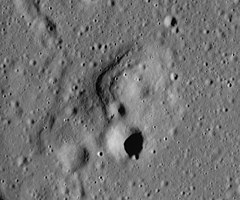 Apollo 15 panoramic camera image | |
| Coordinates | 26°15′N 3°35′E / 26.25°N 3.59°E |
|---|---|
| Diameter | 3.09 km[1] |
| Eponym | Astronaut-named feature |

North Complex is a feature on Earth's Moon, a group of hills in the Hadley–Apennine region. It was an intended destination for the astronauts of the Apollo 15 mission, but due to problems extracting a rock core near the landing site, there was not enough time to make the journey. The hills are thought to be volcanic in origin, but this remains unconfirmed because no samples were collected there.
North Complex is located approximately 2 km east of Hadley Rille, and is about 3 km north of the Apollo 15 landing site itself.
The feature was named by the geologist Gerald G. Schaber,[2] and the name was formally adopted by the IAU in 1973.[1] The astronauts actually called the North Complex "Schaber Hill." The astronauts named many of the small craters on the North Complex, including the 800 m diameter crater informally named Pluton.[3]
See also[edit]
- 3333 Schaber, asteroid named after Gerald G. Schaber
References[edit]
- ^ a b North Complex, Gazetteer of Planetary Nomenclature, International Astronomical Union (IAU) Working Group for Planetary System Nomenclature (WGPSN)
- ^ To a Rocky Moon: A Geologist's History of Lunar Exploration. Don E. Wilhelms, University of Arizona Press (1993), p. 269. ISBN 978-0816510658
- ^ Apollo 15 Named Features Labeled pre-flight photo from Apollo 15 Lunar Surface Journal
External links[edit]
- Apollo 15 Traverses, Lunar Photomap 41B4S4(25)
Well, that’s interesting to know that Psilotum nudum are known as whisk ferns. Psilotum nudum is the commoner species of the two. While the P. flaccidum is a rare species and is found in the tropical islands. Both the species are usually epiphytic in habit and grow upon tree ferns. These species may also be terrestrial and grow in humus or in the crevices of the rocks.
View the detailed Guide of Psilotum nudum: Detailed Study Of Psilotum Nudum (Whisk Fern), Classification, Anatomy, Reproduction